Feather loss in birds is a common problem that affects 80% of pet parrots. It’s important to understand the causes and find the right treatments. Viral diseases, parasites, bad nutrition, and behavior issues can all lead to feather loss.
Key Takeaways
- Feather loss in birds can be caused by many factors, including health problems, parasites, bad nutrition, and behavior issues.
- It’s key to find and treat the cause early to stop more feather loss and help new feathers grow.
- Managing feather loss often needs a mix of vet care, better food, a nice environment, and changing behavior.
- Regular check-ups and parasite tests can catch feather loss problems early.
- Keeping birds happy, stimulated, and comfortable helps prevent feather picking and loss.
Understanding Feather Loss in Birds: Common Causes and Symptoms
Feather loss in birds can be complex, with many causes. It’s key to tell normal molting from abnormal feather loss. This helps in giving the right care and treatment.
Signs of Abnormal Feather Loss
Abnormal feather loss in birds is different from normal molting. Look for patchy feather loss, damaged feathers, and skin problems. Normal molting is gradual and even all over the bird’s body.
Difference Between Molting and Pathological Feather Loss
Molting is when birds shed and replace their feathers naturally. Pathological feather loss is due to health issues or behavior problems. Molting is needed for birds to keep their feathers in good shape. But, pathological feather loss can harm a bird’s health and happiness.
Impact on Bird Health and Well-being
Feather loss can seriously affect a bird’s health and happiness. Feathers help birds keep warm and fly well. Without enough feathers, birds can’t stay warm, fly well, or handle stress as easily.
It’s vital to find and fix the causes of feather loss. This keeps our feathered friends healthy and happy.
Medical Conditions Leading to Feather Loss
Feather loss in birds can signal many health issues. It’s key to know the causes for the right treatment. Viral diseases like Polyomavirus and Psittacine Beak and Feather Disease are common culprits. Bacterial infections, such as Staphylococcus or Pseudomonas, and fungal infections like Aspergillus or Candidiasis also play a role.
Parasites like mites and lice can damage and cause feather loss. Diseases affecting the liver, kidney, or lungs can also show up as feather problems. Getting a correct diagnosis is vital for treating these avian skin conditions.
Hormonal imbalances, diet issues, and diseases like gout or arthritis can make birds uncomfortable. This discomfort can lead to feather picking. Stress, boredom, and bad habits are also common reasons for feather loss.
| Medical Condition | Symptoms | Treatment |
|---|---|---|
| Viral Diseases | Feather loss, beak and claw deformities | Supportive care, feather replacement therapy |
| Bacterial Infections | Skin irritation, feather loss | Antibiotic treatment, topical medications |
| Fungal Infections | Skin lesions, feather loss | Antifungal medications, improved husbandry |
| Parasitic Infestations | Itching, feather damage | Insecticides, improved sanitation |
| Systemic Diseases | Feather loss, poor feather quality | Treat underlying condition, supportive care |
Getting a correct diagnosis and starting treatment quickly is crucial. A detailed vet check and tests can find the cause. This helps in creating the best feather replacement therapy and treatment plan.
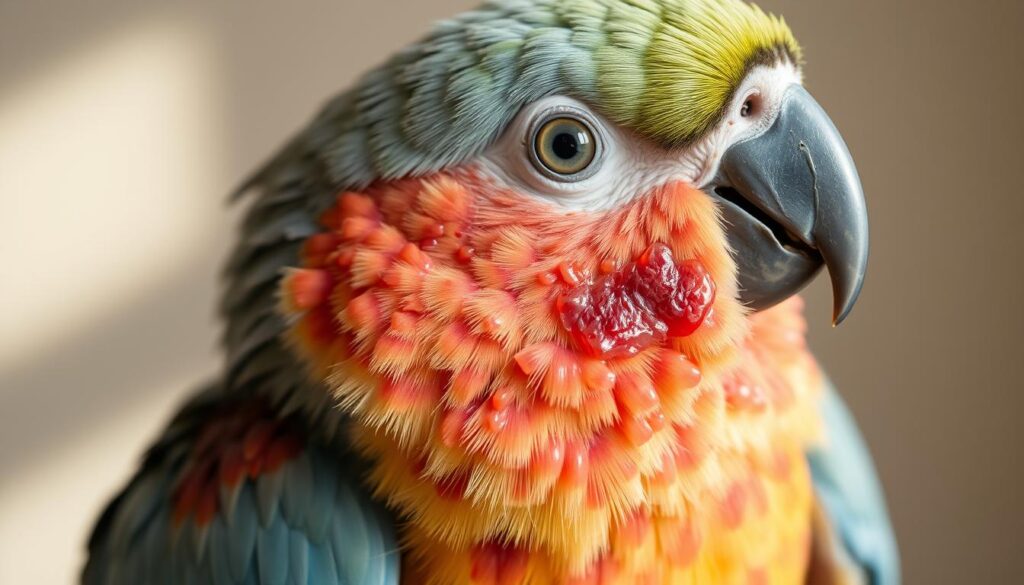
How to Treat Feather Loss in Birds
Dealing with feather loss in birds needs a careful plan. Start by looking at how much and where the feathers are falling off. Check for any skin problems and notice any changes in behavior. This helps figure out what to do next.
Initial Assessment Steps
Start by thoroughly checking the bird’s feathers. Look for any spots where feathers are missing. Also, check the skin for any signs of trouble. Watch the bird’s behavior for any signs of stress or illness.
Emergency Care Guidelines
If the bird’s feathers are falling off fast or if it shows other bad signs, act quickly. Put the bird in a quiet, safe place. Make sure it’s clean, warm, and has good air. If it’s very sick, get a vet right away.
When to Seek Veterinary Help
Some feather loss can be handled at home, but not all. If the loss is all over, or if the bird seems sick, see a vet. They can find out why and help fix it.
Acting fast and taking care of feather loss can really help. It can make the bird’s recovery better and keep it healthy.
Viral and Bacterial Infections Affecting Feathers
Avian feather disorders can be caused by viral and bacterial infections. Polyomavirus and Psittacine Beak and Feather Disease (PBFD) are two major viral infections that harm feathers.
Polyomavirus infections can cause severe feather damage and loss, especially in young birds. Symptoms include abnormal feather growth, color changes, and total feather loss. To diagnose, lab tests are needed to find the virus.
Psittacine Beak and Feather Disease (PBFD) is a contagious viral condition that harms the feathers of parrots and other psittacine birds. It was first seen in the 1970s in Australian cockatoos. Now, it affects over 50 species of wild and pet parrots worldwide, mainly cockatoos, African grey parrots, lovebirds, lories, lorikeets, Eclectus parrots, and budgies.
PBFD can show up in different ways, from quick death in new birds to slow feather problems in older ones. Symptoms include feather loss, deformities, beak changes, and immune system failure. DNA testing is used for diagnosis, but there’s no cure for this deadly disease.
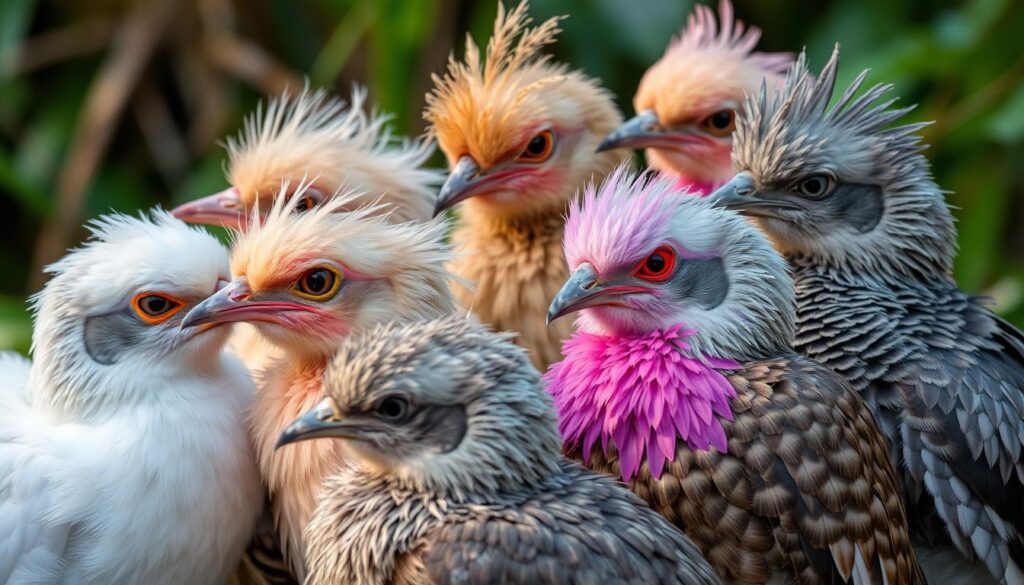
Bacterial infections like Staphylococcus or Pseudomonas can also harm bird feathers. These infections can cause skin irritation and feather loss. Lab cultures are needed for diagnosis, followed by antibiotics and care.
It’s important to prevent viral and bacterial infections to keep bird feathers healthy. Good hygiene, vaccinations, and a stress-free environment help lower the risk of these feather disorders.
Parasitic Infestations and Their Treatment
Feather plucking and skin issues in birds often come from parasites. Mites, lice, and Knemidokoptes (scaly-face, scaly-leg mite) are common culprits. These pests can damage feathers, irritate skin, and leave visible signs.
Common External Parasites
- Mites: These tiny arthropods burrow into skin and feathers. They cause feather loss, skin inflammation, and breathing problems.
- Lice: These wingless insects feed on feathers and skin. They irritate and damage feathers.
- Knemidokoptes: Known as scaly-face or scaly-leg mite, it causes lesions and crusting on beaks and legs.
Treatment Options and Prevention
To treat parasitic infestations, a multi-step plan is needed. Veterinary-prescribed treatments can effectively get rid of these pests. But, preventing them is even more important. Keeping the environment clean, checking for parasites regularly, and quarantining new birds can help a lot.
Follow-up Care Protocol
After treating parasites, watch the bird closely for signs of reinfection. Regular vet visits and fecal exams are key to ensure parasites are gone. Also, treat any secondary infections or health issues that led to the infestation.
Dealing with parasites in birds is tough, but it’s doable with the right approach. By being vigilant and working with avian vets, bird owners can keep their pets healthy and their feathers looking great.
Nutritional Deficiencies and Dietary Solutions
Keeping birds healthy means giving them the right food. A lack of vitamin A can cause feather problems. A balanced diet helps feathers grow and stay healthy.
Many birds suffer from malnutrition, leading to early death. Common issues include protein, calcium, and vitamin A deficiencies. These can cause breathing problems, bad feathers, and weak bones.
To fix these issues, feed high-quality pellets with fresh veggies and fruits. Avoid seed-only diets. Regular weigh-ins and vet-approved diets are key to bird health.
Supplements like UnRuffledRx FeatheredUp! can help. Malnutrition shows in big heads, bad feathers, and mouth plaque.
Fixing nutrition can make birds look and feel better. But, it takes time, patience, and the right food. Sunlight and a good environment also help.
| Nutrient Deficiency | Impact on Feathers |
|---|---|
| Vitamin A | Respiratory issues, poor feather condition, skin problems |
| Vitamin D3 | Weak bones, beak deformities |
| B Complex Vitamins | Lethargy, poor feather condition, neurological issues |
| Protein, Amino Acids | Abnormal feathering, frayed feathers, blisters on feather shafts |
| Zinc | Frayed feathers, blisters on feather shafts, spoon-shaped feathers |
| Riboflavin | Clubbed down in embryos and chicks, swollen tips for each down feather |
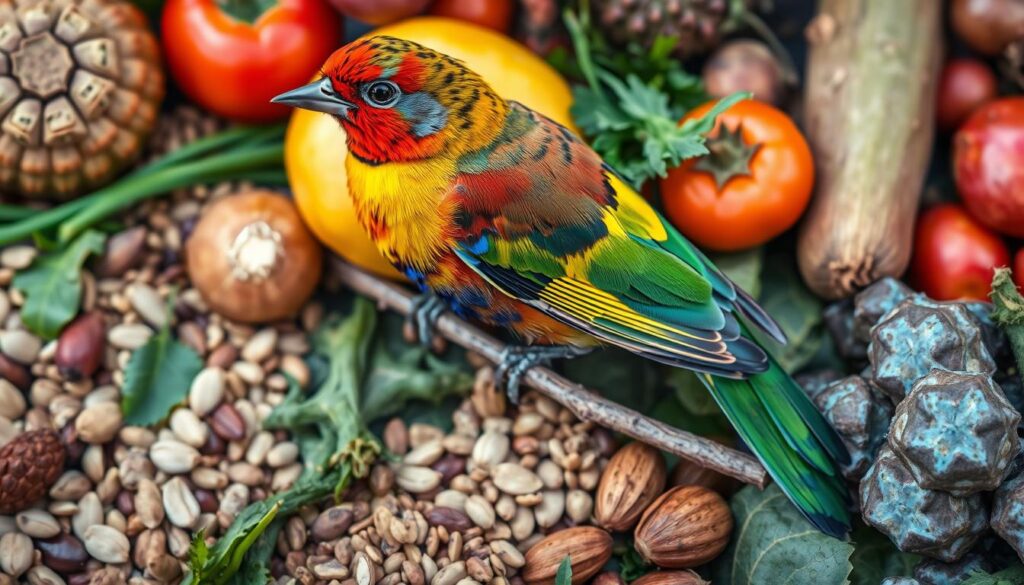
“Regular monitoring and proper diet are key to preventing bird malnutrition.”
Behavioral Causes of Feather Plucking
Feather plucking, or feather picking, is a worrying behavior in birds. They pull out their own feathers repeatedly. This can show physical or emotional problems and is often caused by stress, boredom, or poor care.
Stress Factors
Birds in captivity may pluck their feathers due to stress. This stress can come from bad housing, lack of mental stimulation, or changes in their routine or social life. To stop this behavior, it’s important to enrich their environment and provide a stable, caring home.
Environmental Triggers
Feather plucking can also be caused by changes in the bird’s environment. This includes new family members, rearranging their cage, or not giving them enough chances to forage and nest. Keeping their environment consistent and bird-friendly is key to preventing feather plucking.
Social and Psychological Aspects
Feather plucking can also stem from social and psychological issues. Birds may do this due to frustration with their mates, dominance problems, or other social stressors. Getting help from an avian behaviorist can help find and fix these underlying issues.
It’s vital to tackle the reasons behind feather plucking to improve the bird’s life. A good plan includes enriching their environment, increasing social interaction, and possibly using behavior modification techniques or medication from a vet.
“Proper care, professional guidance, and a supportive environment can significantly improve the quality of life for birds exhibiting feather plucking behavior.”
Environmental Factors and Housing Considerations
Proper housing and environmental factors are key to preventing feather loss and keeping your bird healthy. A good living space, comfortable temperatures, and a clean, safe area are vital. They help support your bird’s well-being and prevent feather problems.
First, think about the size of your bird’s cage. Parrots, for example, spend up to 10 hours a day foraging. They need enough space to move, spread their wings, and behave naturally. Make sure the cage is big enough for your bird to comfortably perch, flap its wings, and move freely.
Choosing the right perches is also important. Use perches of different sizes, textures, and placements. This encourages natural foot and leg movement, helping prevent feather loss and promoting healthy growth. Also, add safe, bird-friendly toys and foraging stations to keep your bird active and curious.
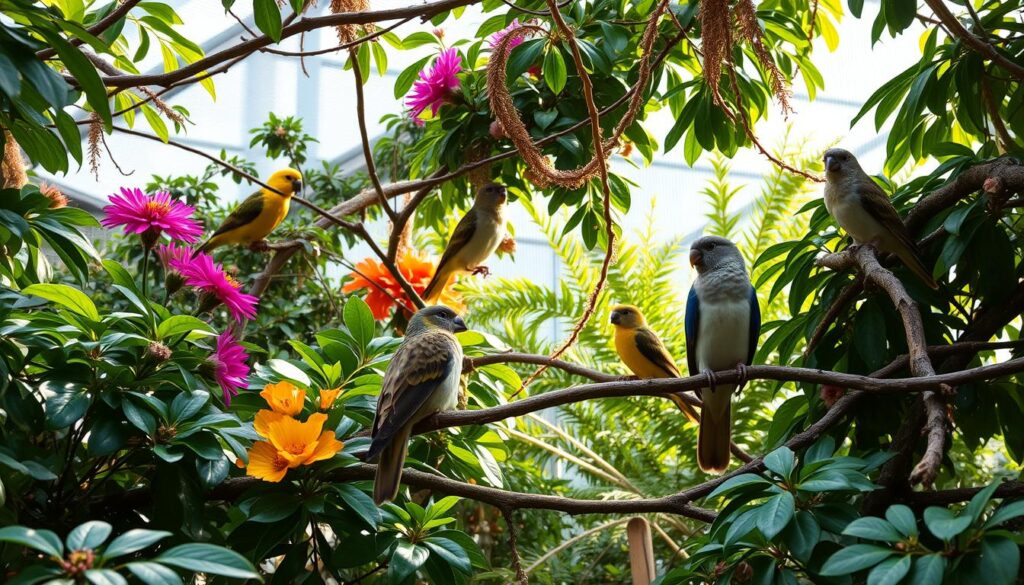
Keeping the right temperature and humidity is crucial for feather health. Parrots do well in humid environments. Low humidity can cause dry skin and feathers, leading to feather plucking and other problems. Make sure your bird’s living area has the correct temperature and humidity levels for its species.
Exposure to toxins like cigarette smoke, household chemicals, and heavy metals can harm your bird’s feathers and health. Watch the air quality and substances your bird may come into contact with. Take steps to reduce any potential dangers.
Regular cleaning and disinfection of the living area are also essential. They help prevent infections and parasitic infestations that can affect feather health and cause feather loss. Keep the environment clean and well-ventilated to support your bird’s overall health.
By focusing on these environmental factors and providing a comfortable, enriched living space, you can help prevent feather loss and promote healthy avian feather disorders.
Prevention Strategies and Best Practices
Keeping your birds healthy and happy is very important. It’s key to stop feather loss to keep them well. A daily care routine and a rich environment can help a lot. This way, you can lower the chance of preventing feather picking and help your birds do well.
Daily Care Routine
Begin each day with health checks on your birds. Look at their feathers, skin, and overall health to catch problems early. A good diet is essential, so feed them well. Keep their home clean and make sure they always have fresh water.
Environmental Enrichment
It’s vital to make their environment fun and engaging for how to treat feather loss in birds. Add toys, foraging spots, and social times to keep them busy and happy. Make sure they have room to move and places to perch. Also, give them 10-12 hours of quiet, dark sleep to reduce stress and stop feather plucking.
Bathing or misting your bird can also help keep their feathers healthy and shiny. Use stress-reducing methods and keep their environment stable to stop feather picking.
“Preventative measures are key to ensuring the long-term health and well-being of your avian companions.”
By following these daily care and enrichment tips, you can stop preventing feather picking and help with treatment of feather loss in birds. Being active and careful in caring for your birds will help keep their beauty and avoid any harm.
Natural Remedies and Supportive Treatments
Natural remedies can help with feather loss and skin issues in birds. They work well with vet treatments. These gentle methods can soothe symptoms and help feathers grow back.
Aloe vera is great for soothing bird skin. It can help with irritation and inflammation. Coconut oil is also useful. It makes feathers strong and healthy.
Chamomile tea can calm stressed birds. It might stop them from plucking feathers. Probiotics help with digestion, which is good for feathers and overall health.
Ultraviolet (UV) light helps with vitamin D. This is key for feather growth and health. But, always talk to a vet before using natural remedies.
| Natural Remedy | Potential Benefits |
|---|---|
| Aloe Vera | Skin soothing and anti-inflammatory properties |
| Coconut Oil | Feather conditioning and nourishment |
| Chamomile | Stress and anxiety relief |
| Probiotics | Gut health support |
| UV Light Exposure | Vitamin D synthesis for feather development |
While natural remedies are helpful, they should not replace vet care. Always work with a vet to find the best treatment for feather replacement therapy and avian skin conditions.
“Integrating natural remedies with professional veterinary care can help optimize the healing and recovery process for birds with feather loss or skin issues.”
Creating an Optimal Recovery Environment
Creating a great recovery space is key for birds with feather loss or picking. A stress-free, clean, and fitting home helps them heal. It also stops more environmental factors for feather loss and preventing feather picking.
First, make sure the bird’s space has the right temperature and humidity. Offer various perches and toys to keep them active and happy. This stops environmental triggers for feather plucking.
Use a quiet spot for a recovery cage, away from noise. Keep things calm and follow a daily routine. Clean the cage often and give fresh food and water for health.
Good food is vital for recovery. Give your bird a balanced diet to fix any nutritional deficiencies. Talk to an avian vet for a special diet plan.
Watch your bird closely and change their space if needed. Look for signs of getting better, like new feathers. Be ready to make changes for the best recovery.
“Creating a safe, enriching environment is essential for birds recovering from feather loss or feather picking. With the right care and attention, they can regain their vibrant plumage and overall health.”
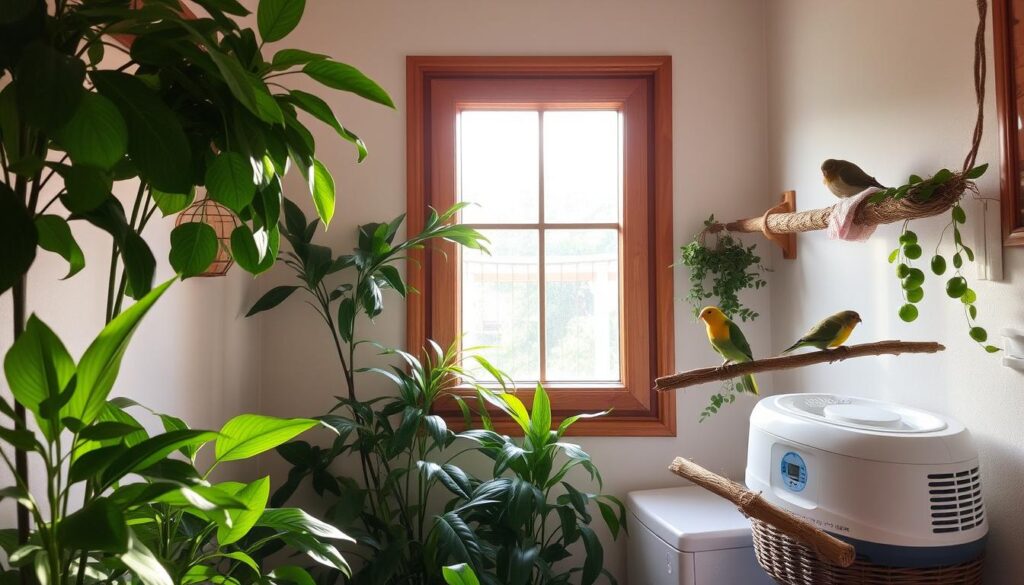
Focus on your bird’s comfort, mind, and health for a great recovery. This way, they can overcome feather issues and look their best again.
Long-term Management and Monitoring
Managing feather loss in birds over time needs careful watching and changes to treatment plans. Regular visits to an avian vet are key. They help track progress, find any hidden health issues, and adjust care as needed.
Progress Tracking Methods
Keep a detailed log of your bird’s feather health, overall health, and any changes in behavior. Use photos to show how new feathers grow. This visual record helps see if treatments are working and guides future steps.
Adjusting Treatment Plans
Be ready for setbacks, as fixing a bird’s feathers can take many molt cycles. Always check and change things like environment, diet, and treatments based on your bird’s response. Being flexible in treatment plans is vital for your bird’s long-term health and successful feather growth.
FAQ
What are the common causes of feather loss in birds?
Birds can lose feathers due to many reasons. These include viral diseases, parasites, and infections. Also, nutritional issues, behavior problems, and environmental factors can cause feather loss.
How can I distinguish between normal molting and pathological feather loss?
Normal molting and abnormal feather loss look different. Normal molting is a natural process. But, abnormal feather loss is not.
Look for patchy feather loss, damaged feathers, and skin irritation. These signs show abnormal feather loss. It can harm a bird’s health, making it hard to keep warm and fly.
What are the medical conditions that can cause feather loss in birds?
Several medical issues can lead to feather loss. Viral diseases like Polyomavirus and Psittacine Beak and Feather Disease are examples. Bacterial infections, such as Staphylococcus or Pseudomonas, and fungal infections like Aspergillus or Candidiasis also cause feather loss.
Parasites, including mites and lice, can damage feathers too.
How should I approach the initial assessment of feather loss in my bird?
First, observe the pattern and extent of feather loss. Check for skin irritation and any behavioral changes. If your bird is showing signs of illness, seek emergency care.
Provide a stress-free environment and address any immediate health concerns.
When should I seek veterinary help for my bird’s feather loss?
You should get veterinary help if your bird’s feather loss is rapid or if they show signs of illness. If home treatments don’t work, it’s time to see a vet. They can give the right diagnosis and treatment.
How can viral and bacterial infections affect feathers in birds?
Viral infections like Polyomavirus and Psittacine Beak and Feather Disease can severely damage feathers. Bacterial infections, such as Staphylococcus or Pseudomonas, can cause skin irritation and feather loss.
Diagnosing these infections often involves lab tests and skin cultures.
What are the common external parasites that can cause feather loss in birds?
Mites, lice, and Knemidokoptes (scaly-face, scaly-leg mite) are common parasites. They can damage feathers and cause skin irritation. Visible parasites are a clear sign of infestation.
Treatment may include topical or systemic antiparasitic medications from a vet.
How can nutritional deficiencies contribute to feather disorders?
Lack of essential nutrients, especially Vitamin A, can harm feathers. A balanced diet is key for healthy plumage. Feed high-quality pelleted foods with fresh vegetables, fruits, and whole grains.
What are the behavioral factors that can lead to feather plucking in birds?
Feather plucking can be due to stress, boredom, or lack of social interaction. Changes in routine or new household members can trigger it. Hormonal imbalances and dominance issues also play a role.
What environmental factors should I consider to prevent feather loss in my bird?
Proper housing is vital. Ensure the cage is big enough, has the right perches, and safe toys. Avoid toxins, cigarette smoke, and chemicals. Keep humidity and temperature levels right.
What are some natural remedies that can complement veterinary treatments for feather loss?
Natural remedies include aloe vera for skin, coconut oil for feathers, and chamomile for stress. Probiotics help with digestion, which benefits feathers. UV light, under controlled conditions, aids in vitamin D synthesis.
How can I create an optimal recovery environment for my bird with feather loss?
Create a stress-free, clean space with the right temperature and humidity. Offer various perches and safe toys for mental stimulation. Keep a routine and ensure proper nutrition and hydration.
What long-term management strategies should I focus on for my bird with feather loss?
Monitor feather condition, health, and behavior regularly. Keep a detailed log of observations, treatments, and diet changes. Use photos to track feather regrowth.
Assess and adjust environmental factors and care routines to support feather health.
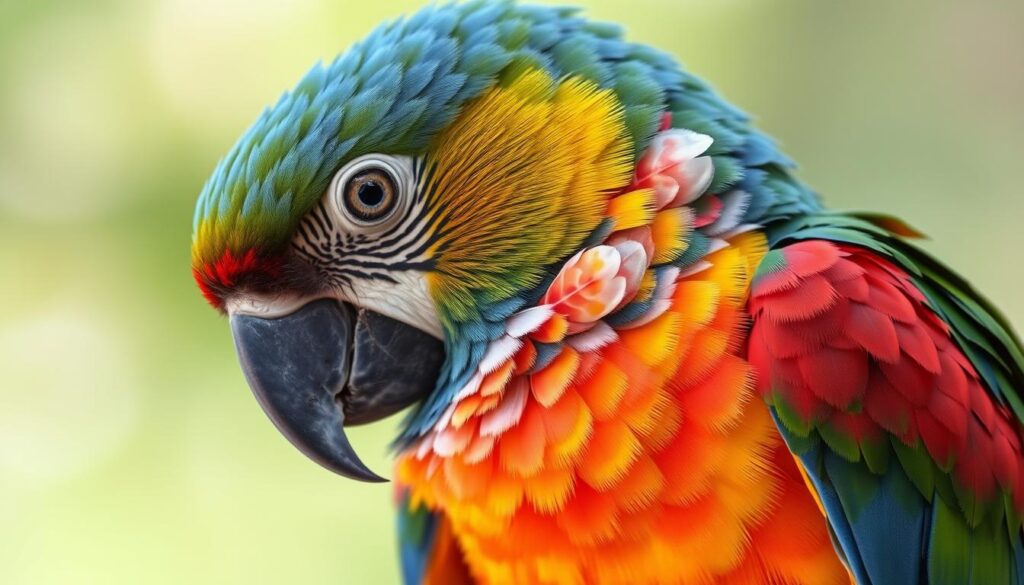

I am really inspired together with your writing abilities as neatly as with the structure in your weblog.
Is this a paid theme or did you customize it yourself?
Anyway keep up the nice quality writing, it’s uncommon to
look a nice weblog like this one today. Stan Store!